
Theres Abbey (German : Kloster Theres) was a Benedictine monastery in the village of Theres in the district of Hassberge, in Franconia in the north of Bavaria, Germany.

Theres Abbey (German : Kloster Theres) was a Benedictine monastery in the village of Theres in the district of Hassberge, in Franconia in the north of Bavaria, Germany.
The monastery, dedicated to Saint Stephen and Saint Vitus, was founded in about 1045 by Bishop Suidger of Bamberg. It was dissolved in 1802 during the secularisation of Bavaria. [1] [2]
The abbey buildings were acquired in 1804 by Theodor von Kretschmann, a government minister of Saxe-Coburg. The church was demolished in 1809. The remaining buildings were converted into a country house. [1] [2]

Ettal Abbey is a Benedictine monastery in the village of Ettal close to Oberammergau and Garmisch-Partenkirchen in Bavaria, Germany. With a community of more than 50 monks, with another five at Wechselburg, the Abbey is one of the largest Benedictine houses and is a major attraction for visitors.

Saint Emmeram's Abbey was a Benedictine monastery founded around 739 at Regensburg in Bavaria at the grave of the itinerant Frankish bishop Saint Emmeram. The original abbey church is now a parish church named St. Emmeram's Basilica. The other buildings on the site form a large complex known as Schloss Thurn und Taxis or Schloss St. Emmeram, which has served as the main residence of the Thurn und Taxis princely family since the early 19th century.

Irsee Abbey, also the Imperial Abbey of Irsee, was a Benedictine abbey located at Irsee near Kaufbeuren in Bavaria. The self-ruling imperial abbey was secularized in the course of the German mediatization of 1802–1803 and its territory annexed to Bavaria. The buildings of the former abbey now house a conference and training centre for Bavarian Swabia.
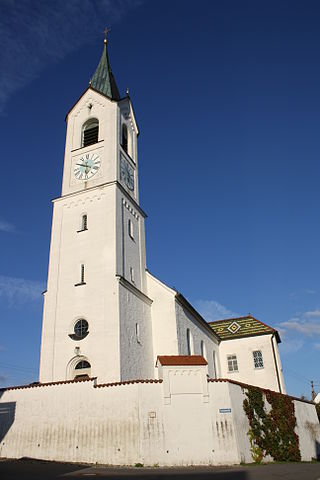
Reistingen Abbey was a house of Augustinian canonesses, previously a Benedictine monastery, at Ziertheim in Bavaria.
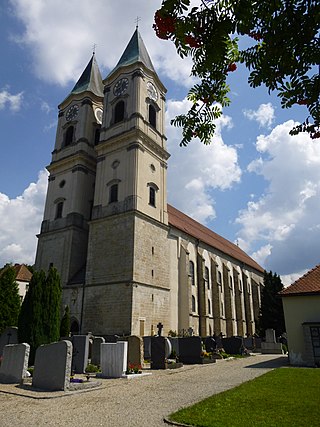
Niederaltaich Abbey is a house of the Benedictine Order founded in 741, situated in the village of Niederalteich on the Danube in Bavaria.

Vornbach Abbey was a Benedictine monastery in Neuhaus am Inn in Bavaria, Germany.

Prüfening Abbey was a Benedictine monastery on the outskirts of Regensburg in Bavaria, Germany. Since the beginning of the 19th century it has also been known as Prüfening Castle. Notably, its extant dedicatory inscription, commemorating the founding of the abbey in 1119, was created by printing and is a unique document of medieval typography.

Schäftlarn Abbey is a Benedictine monastery on the Isar in Schäftlarn, south of Munich in Bavaria, Germany.
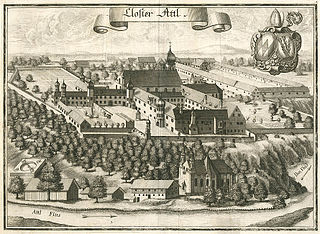
Attel Abbey, also Attl Abbey, was a Benedictine monastery, later a home for the disabled run by the Brothers Hospitallers, in the village of Attel near Wasserburg am Inn in Bavaria, Germany.
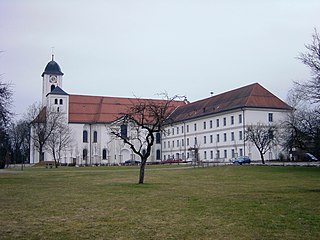
Rott Abbey was a Benedictine monastery in Rott am Inn in Bavaria, Germany.

Weihenstephan Abbey was a Benedictine monastery in Weihenstephan, now part of the district of Freising, in Bavaria, Germany. Brauerei Weihenstephan, located at the monastery site since at least 1040, is said to be the world's oldest continuously operating brewery.
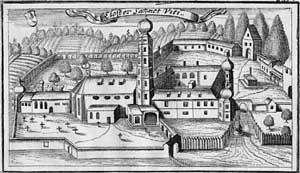
St. Vitus' Abbey, occasionally also St. Vitus' Abbey on the Rott, was a Benedictine monastery in the municipality of Neumarkt-Sankt Veit in the district of Mühldorf in Bavaria, Germany.

Wettenhausen Abbey was an Imperial Abbey of Augustinian Canons until its secularization in 1802–1803. Being one of the 40-odd self-ruling Imperial Abbeys of the Holy Roman Empire, Wettenhaussen Abbey was a virtually independent state. Its abbot had seat and voice in the Imperial Diet, where he sat on the Bench of the Prelates of Swabia. At the time of secularization, the Abbey's territory covered 56 square kilometers and it had about 5,400 subjects.

Banz Abbey, now known as Banz Castle, is a former Benedictine monastery, since 1978 a part of the town of Bad Staffelstein north of Bamberg, Bavaria, southern Germany.

Frauenroth Abbey is a former Cistercian nunnery in Burkardroth in Bavaria, South Germany, in the bishopric of Würzburg
Ursberg Abbey is a former Premonstratensian monastery, now a convent of the Franciscan St. Joseph's Congregation, situated in the small village of Ursberg in the district of Günzburg, Bavaria.

Kornelimünster Abbey, also known as Abbey of the Abbot Saint Benedict of Aniane and Pope Cornelius, is a Benedictine monastery that has been integrated since 1972. The abbey is located in Aachen in North Rhine-Westphalia in Germany.

Neustadt am Main is a community in the Main-Spessart district in the Regierungsbezirk of Lower Franconia (Unterfranken) in Bavaria, Germany and a member of the Verwaltungsgemeinschaft Lohr am Main.
Roggenburg Abbey is a Premonstratensian canonry in Roggenburg near Neu-Ulm, Bavaria, in operation between 1126 and 1802, and again from its re-foundation in 1986. Since 1992 it has been a dependent priory of Windberg Abbey in Lower Bavaria. The monastery manages a training centre and a museum, and is widely known for its almost unchanged Baroque building and the organ concerts that are held in the church.

Prüll Charterhouse, previously Prüll Abbey, is a former Carthusian monastery, or charterhouse, in Regensburg in Bavaria, Germany.
50°01′07″N10°27′01″E / 50.01861°N 10.45028°E